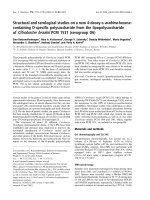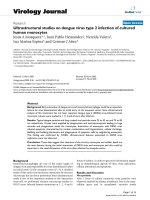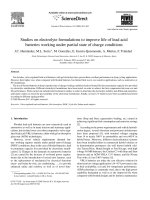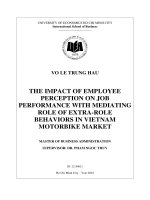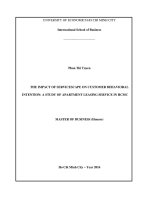Heamatological studies on sida Rhombifolia Ethanolic leaf extract of micronor induced infertility in female rats
Bạn đang xem bản rút gọn của tài liệu. Xem và tải ngay bản đầy đủ của tài liệu tại đây (252.58 KB, 9 trang )
Int.J.Curr.Microbiol.App.Sci (2019) 8(3): 1751-1759
International Journal of Current Microbiology and Applied Sciences
ISSN: 2319-7706 Volume 8 Number 03 (2019)
Journal homepage:
Original Research Article
/>
Heamatological Studies on Sida Rhombifolia Ethanolic Leaf Extract of
Micronor Induced Infertility in Female Rats
R.U. Ukpanukpong1*, R.N. Uyabeme2, F.D. Adebiyi4, D.I. Basiru2,
B.S. Akinfesola2 and P.O. Aigbadumah3
1
2
Department of Biochemistry, University of Calabar, Nigeria
Department of Chemical Sciences, Biochemistry Unit, Joseph Ayo Babalola
University, Osun State, Nigeria
3
Faculty of Medical Sciences, University of Jos, Nigeria
4
Department of Cell Biology and Genetics, University of Lagos, Nigeria
*Corresponding author
ABSTRACT
Keywords
Body Weight
Indices, Weight
Blood cell Count,
Red Blood Cell
Counts Neutrophil
and Mean
Corpuscular
Haemoglobin
Concentration
Article Info
Accepted:
15 February 2019
Available Online:
10 March 2019
The research investigated the heamatological indices of Sida rhombifolia ethanolic leaf
extract on micronor induced infertility in female rats. Sida rhombifolia is a shrub from the
family of Malvaceae. Forty eight (48) female albino rats were randomly placed into six (6)
study groups of eight (8) rats each and designated as; positive control group (PC) placed
on distill water and normal feeds, micronor control group (MC) induced with micronor but
not treated with Sida rhombifolia, Sida rhombifolia control group (SRC), (SRM1, SRM2,
SRM3) induced with micronor and treated with ethanolic leaf extract of Sida rhombifolia
at concentrations of 100mg/kg, 200 mg/kg and 400 mg/kg body weight respectively for 14
days. Animals treated with 200mg/kg and 400mg/kg Sida rhombifolia ethanolic leaf
extract showed a significant increase in white blood cell count activity and neutrophil
concentration compared to the micronor control. There was also a significant increase
(P<0.05) in the red blood cell counts of the extract treated group compared to the positive
control. The extract was found to be non-toxic as seen in the extract fed normal rats.
Findings depicts that ethanolic leaf extract of Sida rhombifolia possessed some
hematopoitic effect on micronor induced infertility in female rats.
Introduction
Sida rhombifolia is a small erect woody, very
variable annual or perennial under shrub
about 1.5 meters high with rough branches
and stellate hairs. Leaves are very variable in
shape up to 5mm by 18 mm, short petioled,
rhomboid-lanceolate to lanceolate, serrated
towards the top, entire towards the base. Sida
rhombifolia
contains
a
variety
of
phytochemicals that has led to its use in many
areas of medicine. Sida rhombifolia is
demulcent, diaphoretic, diuretic, emollient,
stomachic, tonic, sudorific, appetite and
stimulant. It has significant medicinal
applications for which it is cultivated
1751
Int.J.Curr.Microbiol.App.Sci (2019) 8(3): 1751-1759
throughout the world. Leaves and roots are
used for piles, gonorrhea, Diuretic,
aphrodisiac. Roots are held in great repute in
treatment of rheumatism. Stems abound in
mucilage and are employed as demulcents
and emollients both for external and internal
use. The herb is also useful in calculous
troubles and as a febrifuge with pepper.
Mucilage is used as an emollient and for
scorpion sting. Australian aborigines use the
herb to treat diarrhea. Leaves are smoked in
Mexico and a tea is prepared in India for the
stimulation it provides (Bhatt et al., 2003).
Sida rhombifolia is a perennial or sometimes
annual plant in the family Malvaceae, it is
native to the new world tropics and
subtropics. Other common names include
rhombus-leaved sida, paddy’s Lucerne, jelly
leaf and also somewhat confusingly as Cuban
jute, Queensland hemp and Indian hemp
(Although Sida rhombifolia is not related to
either jute or hemp).Synonyms include Malva
rhombifolia. It is used in Ayurvedic medicine,
where it is known as Kurumthotti. This is
another species native to India, Sida
cordifolia. The stems are erect to sprawling
and branched, growing 50 to 120 centimeters
in height, with the lower sections being
woody. The dark green, diamond-shaped
leaves are arranged alternately along the stem,
4 to 8 centimeters long, with petioles that are
less than a third of the length of the leaves.
They are paler below, with short, grayish
hairs. The apical half of the leaves has toothed
or serrated margins while the remainder of the
leaves is untoothed. The petioles have small
spiny stipules at their bases (Kirtikar and
Basu, 2001).
The moderately delicate flowers occur singly
on flower stalks that arise from the area
between the stems and leaf petioles. They
consist of five petals that are 4 to 8
millimeters long, creamy to orange-yellow in
color, and may be somewhat reddish in the
center. Each of the five overlapping petals is
asymmetric, having a long lobe on one side.
The stamens unite in a short column. The fruit
is a ribbed capsule, which breaks up into 8 to
10 segments. The plant blooms throughout the
year. It is usually confined to waste ground,
such as roadsides and rocky areas, stock
camps or rabbit warrens, but can be
competitive in pasture, because of its
unpalatability to livestock (Dukej, 2004).
The hot aqueous extract of dried aerial parts
of Sida rhombifolia is used for snake bite in
East Africa. The hot aqueous extract of entire
plant of S. rhombifolia in Borneo is used as an
abortifacient when it is taken orally by
pregnant women. The hot aqueous extract of
entire plant is used as an abortifacient on oral
administration in pregnant women in Central
Africa (Bhandary et al., 2005). In India, the
decoction of entire plant of S. rhombifolia
when given orally to human adults reduces
rheumatic pain. The decoction is also mixed
with equal proportion of cow’s milk and taken
every morning for about a week for the same
purpose. The hot aqueous extract of the plant
in Malaysia is used for irregular menses when
taken orally by adult females (Zamora and
Pola, 2002).
The decoction prepared from entire plant of S.
rhombifolia in Mexico is used to treat head
cold when applied externally (Amico, 2007).
The hot aqueous extract of the entire plant in
Mozambique is used for cough when given
orally to both sexes of human adults. The
roots and leaves in Honduras are used as
poultice when applied externally on boils
(Sahu, 2004). The hot aqueous extracts of the
entire plant in India is used as an aphrodisiac
and in treatment of fever and urinary diseases
when given orally to adult humans. The
infusion of dried leaf of S. rhombifolia in
Central Africa is used for diabetes, chest pain
and diarrhea on oral administration. The
infusion of this plant is applied locally for the
1752
Int.J.Curr.Microbiol.App.Sci (2019) 8(3): 1751-1759
treatment of skin diseases and infected
wounds.
The leaf juice of the plant in India has been in
use for the treatment of spermatorrhea on oral
administration. The leaf juice of this plant in
Madagascar is applied externally in abscesses
and the leaf is useful in treating menstrual
pain in Argentina (Noumi and Yomi, 2001).
The leaf and root infusions of the plant in
Cameroon are given orally in dysentery and
diarrhea whereas in Mozambique, these are
applied externally as emollient. The decoction
of leaf and root of this plant are given orally
to facilitate child birth (Deka et al., 2003).
The hot aqueous extracts of dried leaf and
root of the plant in India are used to treat
nervous diseases, heart diseases, burning
sensation of the body and as aphrodisiac and
tonic. The decoction of leaf and stem of S.
rhombifolia in Guatemala is taken orally in
urinary inflammation. In India the leaf juice
mixed with sesame oil for the treatment of
snake bite and the fresh leaf juice is given
orally in spermatorrhoea. The fresh leaf juice
in New Guinea has been in use for the
treatment of diarrhea in children. The fresh
plant juice in India, is taken orally to dissolve
stones in urinary tract, while in Nepal, the
plant juice is applied externally for boils
(Burkill, 2006).
Materials and Methods
Materials, equipments and chemicals
Drug: Micronor (BAYER WEIMAR GmbH
and Co.KG Germany/Allemagne), Ethanol
(Fimlab), Centrifuge (Sorvall RC-5B super
speed,
England),
spectrophotometer
(Spectrum lab 22PC England). ELISA KITS
were products of Randox Laboratories
Limited
(Antrim,
United
Kingdom
BT294QY), Analytical weighing balance
(AXIS, model: BT200, Gdansk, Poland).
The animal feed pallet was purchased from
the Osogbo central market, Oshogbo, Osun
State.
Experimental animals
Forty eight (48) adult female albino Wistar
rats between 100-150g were purchased from a
disease free stock of the Ladoke Akintola
University of Technology Medical Laboratory
Osogbo Osun State and used for the study.
The animals were allowed to acclimatize for
two weeks before the commencement of the
experiment. The rats were randomly assigned
on the basis of their weight into six study
groups of eight (8) rats each.
Normal feed and clean running water were
given to the rats ad libitum. They were kept in
wooden cages of eight (8) rats per cage,
placed in the well-ventilated animal house of
Joseph Ayo Babalola University Ikeji Arakeji
Osun State at normal temperature of 30-35oC.
The cages were cleaned regularly and the rats
were treated according to the international
guidelines for the care and use of laboratory
animals (NIH, 2008).
Plant materials and identification
Fresh and healthy plants of Sida rhombifolia
was obtained from the Federal University of
Agriculture, Ijapo, Akure, Ondo State,
Nigeria. The plant samples were taken to the
Department of Botany, Obafemi Awolowo
University, Ile-Ife for identification and
authentication.
Preparation of plant extract
The Sida rhomibifolia plants were sorted out
and thoroughly washed to get rid of sand, the
leaves were detached from the entire plant
and allowed to air dry properly under a shade
for 2 weeks. The dried leaves were then
grounded properly to powder with the use of
1753
Int.J.Curr.Microbiol.App.Sci (2019) 8(3): 1751-1759
an electric blender. The powdered form was
stored in an air tight container and stored until
needed.
Extraction procedure
About 100 grams of the powdered leaves was
soaked in 400 ml 98% ethanol-water (1:1) at
room temperature for 3 days after which the
mixture was filtered with a Whatman filter
paper (No. 1). The filtrate was allowed to dry
at room temperature in stainless plates after
which it was scraped out and kept in an air
tight container. The dried extract was
dissolved in water to make 100, 200 and
400mg/kg and stored.
Induction of infertility
Infertility was induced by administering oral
doses of 0.5mg/kg of Micronor for 5 days.
15mg of the Micronor was dissolved in 250
ml of water and administered orally to the rats
1ml/day with the aid of cannula tubes. And
then they were allowed to co-habit with male
rats after which they were left for 30 days to
ensure that they were infertile before further
treatment.
Experimental design
The grouping and treatment given to the rats
in each of the groups are as follows: Group 1;
designated PC consisted of positive control
rats (Normal female rats). Group 2;
designated as MC consisted of Micronor
Induced
Control
rats
(Female
rats
administered Micronor only). Group 3;
designated as SRC consisted of extract
control rats (Female rats administered
200mg/kg of Sida rhombifolia ethanolic leaf
extract only).
Group 4; designated SRM1 consisted of
Micronor induced female rats administered
100mg/kg of Sida rhombifolia ethanolic leaf
extract. Group 5: designated SRM2 consisted
of Micronor induced female rats administered
200mg/kg of Sida rhombifolia ethanolic leaf
extract. Group 6; designated SRM3 consisted
of Micronor induced female rats administered
400mg/kg of Sida rhombifolia ethanolic leaf
extract.
Sacrifice of
collection
the
animals
and
blood
At the end of the experimental period, rats in
each study group were fasted overnight and
sacrificed under anesthesia by cardiac
puncture, blood was dispensed into specific
sterile bottles (plain bottle for hormonal and
cholesterol assay, EDTA bottles for
Hematological indices).
Hematological analysis
Packed cell volume
Method: Micro haematocrit (Baker and
Silverton, 2003)
Materials: Capillary tube, Haematocrit
centrifuge, Haematocrit reader, Plasticine.
Principle: Anticoagulant blood in a glass
capillary of specified length, bore size and
wall thickness is centrifuged at 12,000 rpm
for 5 minutes to obtain a constant packing of
the red blood cells while the plasma remains
above the cells.
Procedure: The capillary tube was filled with
the mixed blood up to ¾ of its length, one of
the ends of the capillary was sealed with
plasticine. It was placed in the centrifuge and
spun for 5mins at 12,000rpm. It was then read
on the hematocrit reader.
Total white blood cell count
This was determined using bulk dilution
method of Ochei and Kolhatkar (2007).
1754
Int.J.Curr.Microbiol.App.Sci (2019) 8(3): 1751-1759
Differential white cell count
Haemoglobin estimation
Haemoglobin was determined using the
method of (Baker and Silverton, 2003).
Mean
corpuscular
concentration
hemoglobin
Principle: The mean corpuscular hemoglobin
concentration is a measure of the
concentration of hemoglobin in a given
volume of packed cell blood cells. It is
reported as part of standard complete blood
count.
Method: It was calculated by dividing the
hemoglobin by the hematocrit. Reference
ranges for blood tests are 32 to 36 g/dl, or
between 19.9 and 22.3 mmol/l. It is this a
mass or molar concentration.
Statistical analysis
The data were expressed as mean value
S.E.M (standard error of mean). All results
were mean of 8 determinations and the
statistical analysis was carried out using
students’ t-test. The values were considered at
probability level of P< 0.05. All the values of
P< 0.05 were considered statistically
significant.
Results and Discussion
This experiment evaluated the effect of the
ethanolic leaf extract of Sida rhombifolia on
hematological parameters of micronorinduced infertile female albino Wistar rats.
Change in body weight is used as an
assessment of the response of an individual to
therapeutic drugs and as an indication of the
adverse effect of the drug (Teo et al., 2012).
In this study, Sida rhombifolia had an
increasing effect on the body weight in a dose
dependent manner which may be associated
with the fact that Sida rhombifolia has an
appetizing effect on the rats and they fed
better during the experiment as earlier
suggested by (Adeneye and Agbaje, 2008),
rats treated with varying concentrations of
ethanolic leaf extract of Sida rhombifolia
(100,
200
and
400mg/kg)
showed
proportional increase in body weight. It could
also be that Sida rhombifolia interferes with
the lipid metabolism of experimental animals.
However, it was generally observed that there
was a relatively significant increase in the
final body weight when compared to the
initial.
Blood parameters are good indicators of
physiological, pathological and nutritional
state of an animal and changes in
hematological parameters gives an insight to a
pathological condition and explains the
impact of therapeutic drug testing.
Various medicinal herbs or conventional
drugs/chemicals adversely affect certain
blood components (Messaudi et al., 2008).
Haemolyticanaemia and thromocytopaenia is
known to be induced by flavonoids from
herbs (Logeswari et al., 2012).
Hematological indices considered in the
experiment were White blood cell activity,
Red
blood
cell
count,
Neutrophil
concentration
and
Mean
corpuscular
hemoglobin concentration. In this study, a
significant increase was observed in WBC
activity and neutrophil concentration of
SRM2 and SRM3 (p<0.05) compared to the
positive control.
This might be due to the participation of
neutrophils and monocytes in the process of
phagocytosis as scavengers for a wide variety
of particulate material (Sireeratawong et al.,
1755
Int.J.Curr.Microbiol.App.Sci (2019) 8(3): 1751-1759
2014). It might also be the result of repair
processes of hemopoiesis as neutrophils are
the first line of defense mechanism (Gangu et
al., 2011) (Fig. 1–5).
Fig.1 A graph showing the Body weight of rats in various study groups
Values expressed in Mean ± SEM of 8 determinations
PC: Positive control
MC: Micronor induced control (Negative control)
SRC: Sida rhombifolia control
SRM1: Micronor + Sidarhombifolia (100mg/kg)
SRM2: Micronor + Sidarhombifolia (200mg/kg)
SRM3: Micronor + Sidarhombifolia (400mg/kg)
IBW: Initial Body Weight (Before the experiment)
FBW: Final Body Weight (After the experiment)
a: shows significant difference when compared to Positive control (p<0.05)
b: shows significant difference when compared to Micronor induced control (p<0.05)
Fig.2 A graph showing the White blood cell activity of rats in various study groups
Values expressed in Mean ± SEM of 8 determinations
PC: Positive control
MC: Micronor induced control (Negative control)
SRC: Sida rhombifolia control
SRM1: Micronor + Sida rhombifolia (100mg/kg)
SRM2: Micronor + Sida rhombifolia (200mg/kg)
SRM3: Micronor + Sida rhombifolia (400mg/kg)
a: shows significant difference when compared to Positive control (p<0.05)
b: shows significant difference when compared to Micronor induced control (p<0.05)
1756
Int.J.Curr.Microbiol.App.Sci (2019) 8(3): 1751-1759
Fig.3 A graph showing the Red blood cell count of rats in various study groups
Values expressed in Mean ± SEM of 8 determinations
PC: Positive control
MC: Micronor induced control (Negative control)
SRC: Sida rhombifolia control
SRM1: Micronor + Sida rhombifolia (100mg/kg)
SRM2: Micronor + Sida rhombifolia (200mg/kg)
SRM3: Micronor + Sida rhombifolia (400mg/kg)
a: shows significant difference when compared to Positive control (p<0.05)
b: shows significant difference when compared to Micronor induced control (p<0.05)
Fig.4 A graph showing the Neutrophil concentration of rats in various study groups
Values expressed in Mean ± SEM of 8 determinations
PC: Positive control
MC: Micronor induced control (Negative control)
SRC: Sida rhombifolia control
SRM1: Micronor + Sida rhombifolia (100mg/kg)
SRM2: Micronor + Sida rhombifolia (200mg/kg)
SRM3: Micronor + Sida rhombifolia (400mg/kg)
a: shows significant difference when compared to Positive control (p<0.05)
b: shows significant difference when compared to Micronor induced control (p<0.05)
1757
Int.J.Curr.Microbiol.App.Sci (2019) 8(3): 1751-1759
Fig.5 A graph showing the mean corpuscular hemoglobin concentration of rats in various study
groups
Values expressed in Mean ± SEM of 8 determinations
PC: Positive control
MC: Micronor induced control (Negative control)
SRC: Sida rhombifolia control
SRM1: Micronor + Sida rhombifolia (100mg/kg)
SRM2: Micronor + Sida rhombifolia (200mg/kg)
SRM3: Micronor + Sida rhombifolia (400mg/kg)
a: shows significant difference when compared to Positive control (p<0.05)
b: shows significant difference when compared to Micronor induced control (p<0.05)
It was recorded in the study that there is a
significant increase in mean corpuscular
hemoglobin concentration of the treatment
groups SRM2 and SRM3 compared to the
micronor control group the result suggests
that Sida rhombifolia may alleviate the
anemic effects of micronor. Red blood cell
count in the treatment groups SRM2 and
SRM3 was also found to have significantly
increased when compared to the positive
control.
In conclusion, the biological effects of the
ethanolic leaf extract of Sida rhombifolia
obtained in this study supports the therapeutic
use of Sida rhombifolia for treatment of
endocrine related infertility and facilitation of
fertility. The extract increased the levels of
luteinizing hormone and estrogen of rats at
low, moderate and high doses, possibly due to
the presence of phyto-estrogens in the leaf of
Sida rhombifolia.
References
Adeneye, A.A. and E.O. Agbaje, (2008).
Pharmacological
evaluation
of
oral
hypoglycemic and antidiabetic effects of
fresh leaves ethanol extract of Morinda
lucida Benth. In normal and alloxan-induced
diabetic rats. Afr. J. Biomed. Res., 11: 65-71.
Amico, A. (2007). Medicinal plant of Southern
Zambesia, Fitoterapia, 48: 101-139.
Baker, R. and Silverton, T.(2003). Blood:
Principles and Practice of Hematology.
Lippincott Williams and Wilkins, 2(4): 183189.
Bhatt, D. J., Baxi, A. J and Parikh, A. R. (2003).
Chemical investigations of the leaves of
Sidar hombifolia Linn., Journal of Indian
Chemical Society, 60: 98.
Burkill, I. H. (2006). Dictionary of the economic
1758
Int.J.Curr.Microbiol.App.Sci (2019) 8(3): 1751-1759
products of the Malay Penisula, Ministry of
Agriculture and Co-operatives, Kuala,
Lumpur, 155-189.
Deka, L, Majumdar, R. and Dutta, A. M. (2003).
Some Ayurvedic important plants from
district Kamrup, Ancient Science of Life, 3:
108-115.
Dukej, J A. (2004). Amazonian Ethnobotanical
Dictionary, USA, 181.
Gangu, A. R., Prapulla, P., Anilkumar, C. H.,
Chamundeeswari, D. and Reddy, U. M.
(2011). Free radical scavenging activity of
the alcoholic extract of Sida rhombifolia
roots in arthritic rats. Int. J. Res. Pharm.
Chem. 1(3): 624-629.
Kirtikar, K.R and Basu, B.S. (2001). Indian
medicinal plants, published by Mohen
Basulalit, Allahabad. The ayurvedic
pharmacopoeia
of
Indian,
part
1,
Department of AYUSH, ministry of Health
and family welfare, Government of India,
Vol-3: 24-46
Logeswari., P.T.A, Dineshkumar, V. and Prathap
Kumar S.M. (). Efficacy of Sida rhombifolia
root on cadmium chloride induced
hematological
alterations
in
rats.
International Journal of Pharmacy and
Technology. (2): 4741-4746.
Messaoudi, I., Hammouda, F., Heni, J. E., Baati,
T., Said, K. and Kerkeni, A. (2010). Reversal
of Cadmium-induced oxidative stress in rat
erythrocytes by Selenium, Zinc or their
combination. Exp. Toxicol. Pathol. 62(3):
281-288.
National Institute of Health (2008). Guide for the
care and use of laboratory animals. 1(14):
82-86.
Noumi, E. and Yomi, A (2001). Medicinal plants
used in for intestinal diseases in Mbalmaya
region, central province, Cameroon:
Fitoterapia, 72: 246-254.
Shibeshil, W., Makonnen, E., Debella, A. and
Zerihun,
L.
(2006).
Phytochemical,
contraceptive efficacy and safety evaluations
of the methanolic leaves extract of
Achyranthesaspera L. in rats, Pharmacol.,
3:217-224.
Ochei, R.and Kolhatkar,J.(2007). “InvivonearInfrared spectroscopy”. Annual Review of
Biomedical Engineering 6(2): 715-754.
Odebiyi, A. and Sofowora, A.E. (1978).
Phytochemical Screening of Nigerian
Medicinal Plants. Part III. Lloydia 41: 234246.
Teo, E.Y., Lew, P.S. and Feo, C.S. (2012): Public
perception of obesity and bariatrics surgery
in Singapore; A pilot study, Singapore
Medical Journal, 53: 104-108
Sahu, TR. (2004). Less unknown uses of weed as
medicinal plants, Ancient science of life, 3:
245-249
Sofowora, A. (1993). Medicinal plants and
Traditional Medicine in Africa. 2nd Ed.
Spectrum Books Limited (Publisher),
Ibadan, Nigeria, pp. 134-56.
Sireeratawong, S., Lertprasertsuke, N., Srisawat,
U., Thuppia, A., Ngamjariyawat, A.,
Suwanlikhid, N. and Jaijoy, K. (2014).
Acute and subchronic toxicity study of the
water extract from root of Sida rhombifolia
in
rats,
Afri.
Journal
Traditional
Complimentary Alternative Medicine 24(7):
10-26.
Zamora-Martinez and Pola CNP. (2002).
Medicinal plants used in some rural
populations of Oaxaca, Puebla and Veracruz,
Mexico, Journal of Ethnopharmacology, 35:
229-257.
How to cite this article:
Ukpanukpong, R.U., R.N. Uyabeme, F.D. Adebiyi, D.I. Basiru, B.S. Akinfesola and
Aigbadumah, P.O. 2019. Heamatological Studies on Sida Rhombifolia Ethanolic Leaf Extract
of Micronor Induced Infertility in Female Rats. Int.J.Curr.Microbiol.App.Sci. 8(03): 17511759. doi: />
1759
